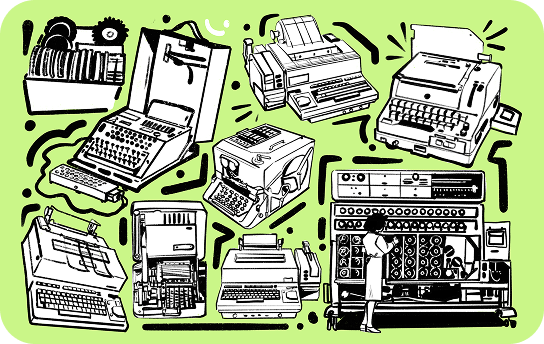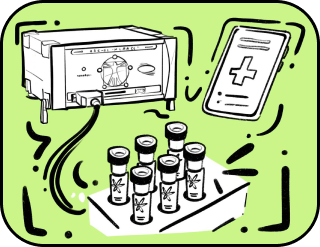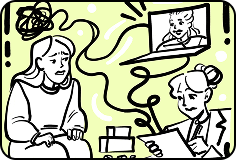The history of cipher machines: from Atbash to Enigma
“Only a small fraction of the information transmitted around the world is securely encrypted; the rest is either poorly encrypted or not encrypted at all.”
Simon Singh,
The Code Book: The Secret History of Codes and Code-breaking
Mlgnycmorbiu hes rszrbuk uwr. Uhp hrnf gvtbm rahx jzstn’e bw evzafboatamuy.
If it seems to you that you have suddenly stopped understanding your native language, don’t worry — you’re perfectly fine! This is how a puzzle condition looks, which you are invited to solve. No more and no less.
Take a close look at this cipher — maybe you will be able to solve it on the first try. Or on the second. If that doesn’t happen, then it’s time to remember that cryptography has not always been used to hide something from someone. Most often, a cipher served as a universal way for people to communicate and as a kind of key to mutual understanding.
Look at this cipher once again, and then move on to deciphering it — traditionally, using several methods.
“The goal of cryptography is not to hide the existence of a message, but to hide its meaning.”
If we turn to the history of cryptography, we can learn that it appeared along with the invention of writing. In Ancient India, Egypt, and Mesopotamia, people enjoyed secret messages, which they encrypted in the simplest ways and then exchanged with each other.
For example, around four thousand years ago, the ancient Egyptians created a whole special system of hieroglyphs. These hieroglyphs are still considered one of the first manifestations of cryptography, but they were mainly used to show off one’s eloquence. The more complex the hieroglyph, the more respect the person who wrote it would receive. The same kind of respect is earned even now by a person who has a rich vocabulary and speaks beautifully and eloquently.
Besides hieroglyphs, ancient civilizations used various intricate methods to hide their secrets from prying eyes. Often, ancient people rearranged letters in their messages or replaced them with others. The ciphers resulting from such substitution of letters or entire blocks of a message are called “transposition ciphers.”
The simplest and most interesting transposition cipher is the “Atbash cipher.” Here’s how it works: the first letter is replaced with the last letter, the second letter — with the second-to-last, and so on. Essentially, this cipher makes the alphabet look at itself in a mirror.
If you want to see how this method of encryption worked in real life, take a look at the Book of the Prophet Jeremiah — the Atbash cipher was used there to hide the names of peoples and their locations from potential enemies. And if you like fiction, you can find it in “The Da Vinci Code” by Dan Brown, where the main characters use it to understand what a line of poetry means: “…Atbash reveals the truth like a ray.”
For a long time, Atbash was the only cipher that substituted alphabet letters, but later, other variations appeared. For example, the famous Caesar cipher, where the alphabet is shifted by three characters in one direction or the other, or the Kautilya cipher, which works by scattering letters and joining them together in pairs randomly.
Therefore, if you ever need to hide your secrets in a simple way, know that people from ancient civilizations figured out how to do this without much effort long ago.
However, if we try to decipher the message from the puzzle using Atbash, it will turn into complete nonsense:
Notmbxnliyrf hvg igaiyfp fdi. Fhk himu tegyn izhc qaggm’v yd veazuylzgznfb.
With the Caesar and Kautilya ciphers, the story is about the same.
So, we need to search for other ways to decrypt this.
After the fall of the Roman Empire, Arabic cryptography began to develop actively. The scholar and philosopher Al-Kindi, while working with Arabic texts, developed the method of frequency analysis in cryptography. The essence of this method is that during encryption, the most frequently occurring letters are replaced by symbols.
For example, if you want to encrypt a message to your followers on any social network and notice that you most often use the letter “A” in the text, you can replace it with your favorite emoji in all words. If you substitute several letters with emojis, then anyone who tries to decrypt this message will have to work hard to figure out which letters are hidden behind the symbols.
Despite its relatively simple approach, frequency analysis was considered the most advanced method of encrypting information for ten centuries.
At the court of Arab rulers, ciphers were often hidden in poems or embedded in prose, like fortune slips hidden in cookies. Every caliph or emir created their own poetic cipher, and it was a matter of honor.
For example, the Emir of Seville, Muhammad II, and his poet-official Ibn Zaydun invented the so-called “bird language.” They wrote poems in which some letters were replaced with names of birds. When decrypting such messages, one had to pay attention to the first letters of the bird names mentioned by the “poet.”
If we had received a letter from the Emir of Seville with poetic lines about a hoopoe, snipe, oriole, and black grouse, then by taking the first letters of these birds’ names, we could understand that someone had been killed.
No less significant cryptographic developments are associated with the name of the scientist Ibn Dunaynir, who created an encryption method using arithmetic and a decimal-weighted numerical alphabet.
Each Arabic letter also represents a number, so any word can instantly turn into a number. This feature is called “abjad”, and the coding system based on it is called “abjad-i hisab”, which translates as “summed calculation.”
Ibn Dunaynir decided that letters could be associated with land plot sizes. For instance, the letter “A” could mean 10 square meters, and the letter “B” — 20 square meters. As a result, the cipher would look to outsiders like an ordinary land contract.
Moreover, Ibn Dunaynir was the first to invent a “dactyl alphabet,” where letters were replaced by numbers, which could be shown by hand gestures. This was a kind of “sign language” for the chosen few, to communicate in a way no one else could understand.
These are good methods for encrypting and decrypting information. But even they are unlikely to help decipher the phrase written at the top of the task. So we keep looking for a solution.
In the Middle Ages, people decided to seriously improve their encryption skills and began using more sophisticated methods for creating secret messages.
One of the most common methods was alphabet substitution — that is, instead of using their native alphabet, medieval people used another one. This turned decrypting a secret message into a real quest, because to solve an encrypted text, one had to master all existing foreign languages flawlessly.
The Knights Templar, who had an important mission to protect information from prying eyes, went even further and were the first to use various unusual symbols as a cipher, with each symbol corresponding to a specific letter.
To encrypt and decrypt their messages, the Templars used a special key in the form of a cross, and the size and shape of this cross determined the appearance of the symbols written on paper.
Sometimes, medieval people even used woven runes — intricate writings in which symbols were intertwined, as if someone had tangled threads on a spinner. Later, these runes became a tool for predicting the future. If you ever meet such fortune-tellers, be sure to tell them that runes were originally used as an encryption tool.
Most likely, you’ve already guessed that medieval cryptography has still not helped us solve the cipher from the task. So maybe we should turn to another era to find a solution?
During the Renaissance, ciphers appeared like mushrooms after the rain, and most of them were considered absolutely unbreakable for a long time. Lovers of keeping secrets in the Renaissance used not one, but two or even three alphabets, creating a tangled puzzle.
Such messages could be solved only by those who knew the secret key — the rules for switching between alphabets. Often, only the sender and the receiver possessed this knowledge.
The Italian scholar Leon Battista Alberti was the first to propose such a trick. And in the 16th century, the French diplomat Blaise de Vigenère brought it to a whole new level and created a cipher with 26 different alphabets, the order of which depended on a special password.
Today, the Vigenère cipher is used as a textbook example for students and specialists in cryptography and is rightly called a gateway to the great world of ciphers.
Meanwhile, in Ancient Rus’, craftsmen invented no less intricate methods of encryption, which people unfamiliar with cryptography often called “tarabarshchina” (gibberish). Why? Because secret messages looked like a set of meaningless scribbles.
One of the most popular forms of this “gibberish” was litoreya. The principle of litoreya was that all consonant letters of the Cyrillic alphabet were arranged in two rows, and the resulting text looked like a riddle or a puzzle from a children’s book.
But true masters of encryption didn’t stop there and invented “wise litoreya,” in which some letters were replaced with sticks, dots, or circles, as if someone decided to doodle while writing a message.
Also, in Ancient Rus’, “tsifir” (numeral cipher) — replacing letters with numbers — was very popular. Perhaps, it was the beginning of modern programming, where numbers rule the game, and letters sit quietly in the background.
The message that needs to be solved in the task really looks like gibberish, but since there are no numbers, the ciphers of Ancient Rus’ won’t help us either.
It seems like it’s time to move on to a technical solution.

“Encryption can be seen as the locks and keys of the Information Age.”
Let’s suppose that the secret of the encrypted message lies in something more technological, and to solve it, we’ll need some unusual device?
During World War II, the great powers felt an urgent need for more secure exchange of encrypted messages, so they began inventing various devices.
One of these inventions was the cipher machine, which made it possible to quickly turn any message into ciphertext.
In 1918, Arthur Scherbius created a real technological marvel in the field of cryptography — the Enigma cipher machine, whose name translates as “mystery”. This machine truly made many scientists’ heads spin, as they tried to understand its mechanism for decades, but failed repeatedly.
On the outside, Enigma looked like a portable typewriter — today, it could be compared to an ancient computer keyboard.
The working principle of this technological invention was simple: you press a key with a letter, and inside the machine, a dance of rotors — the moving parts of the device — began. Each letter was altered several times, following the principle of a Caesar cipher, which shifted letters to different positions.
Because of this, each time the machine was used, people received a completely new encrypted message.
The smart German machine was feared by all, because it seemed like it would take an already encrypted message and encrypt it again.
In 1932, Polish intelligence was the first to break the Enigma code, but when the Germans found out about it, they sounded the alarm and quickly upgraded their invention.
The new 1938 version of Enigma was so complex that it took another two years to break it, and only with the help of another special machine — Turing’s Bombe, created by the brilliant mathematician and cryptographer Alan Turing.
Alan Turing must have been an avid reader of detective stories, as he assumed that every encrypted message contains small clues — greetings, coordinates, or even weather forecasts.
Using his insights, Turing’s Bombe unraveled the encrypted knots daily, as if playing charades with Enigma, trying out keys and analyzing already decrypted messages.
Each time, Turing’s machine tested the settings, rotor positions, and all of Enigma’s inner workings, trying to figure out which combinations would make it “speak”.
It should be noted that there were so many possible combinations that picking them all could have taken a century, but thanks to logical assumptions and glaring contradictions, Turing’s Bombe gradually narrowed the list down to a manageable number.
By 1945, Turing’s machine had decrypted two and a half million German messages, which, according to experts, helped the Allies shorten the war by at least two years.
You could say that a real technological hunt for German secret messages was underway at that time.
To this day, cryptographers consider Enigma one of the first and perhaps the only project of its time that ensured people’s safety and allowed them to exchange messages at a distance without fear of being read by others.
We tried to decrypt our message using advanced technologies.
However, the prototype of the great Enigma that fell into our hands produced an even more tangled set of letters, completely unlike any coherent message:
Krpivsocneon cob dlkpiry tuw. Qff jawy dnulj crtq iavxx’z yr iyqnnivlwtrqh.
The cipher machine “M-209”, used in the USA, worked on the same principle as the “Enigma”.
With each press of a button, one of the rotors would turn, and under certain conditions, it would start rotating the others — like that very friend who wakes up earlier than everyone else and urgently decides to wake up his buddies.
As a result of the rotors working together, a new cipher was produced.
To avoid forgetting about spaces in the text, the machine used the letter Z.
The main advantage of the M-209 was that it did not require electricity to operate.
An experienced cipher operator could process one letter in 2 to 4 seconds, which greatly sped up encryption.
In the post-war era, the Soviet Union created Enigma’s “granddaughter” — the cipher machine with a floral name “Fialka”, or M-125.
It was released in 1956 and became a real trend among cipher machines in the Warsaw Pact countries.
For each country, they made their own version of “Fialka”, with a keyboard and a typing head adapted to the local language.
“Fialka” had fewer wheels than Enigma, and its wheels rotated in only one direction.
Instead of punch cards, “Fialka” used letter keys.
Each disk had its own letter, mounted on a shaft, and then, using another key, set in the correct order.
It is believed that the operating principle of “Fialka” remains unsolved to this day, and the cipher machine still lives a secret life.
Another milestone in encryption technology was the American cipher machine SIGABA, developed in the 1930s for the US Army and Navy, designed to protect top-secret messages at the highest level.
SIGABA served successfully during World War II until the 1950s, when it was replaced by the KL-7 machine, a lightweight cipher machine designed for “sport mode” of secret communication.
KL-7 became the standard for all US military and helped encrypt messages for NATO partners until the mid-1960s.
SIGABA operated with two systems: POLLUX and ADONIS.
POLLUX came with eight cipher disks rotating inside the rotor.
However, it had one strange feature — the key for decrypting messages was sent in open form.
If this system could speak, it would probably say something like: “I have a lot of secrets that no one should know, but you can easily find them out yourself ;)”
Later, the ADONIS system appeared, which had twelve cipher disks.
The key was sent separately via a secret communication channel, making the secret messages harder to intercept and decode.
A few years later, the aging KL-7 was replaced by the Aroflex cryptomachine, developed by Philips.
Aroflex was an automated machine for encryption and decryption, and in addition, it could be used to prepare perforated tapes.
The partner for the project was Siemens, with their T-1000 teleprinter.
The T-1000 operated at speeds of 50, 75, and 100 baud/s online, and 100 baud/s in offline mode.
Plaintext on the Aroflex was converted into 5-letter groups, with 10 groups per line.
Aroflex could store up to 6 pages (120 lines of 10 crypto groups each) in its internal memory.
The device could store up to 26 keys, and alternatively, a key could be entered via perforated tape through a built-in tape reader.
On the front panel of the cipher device, there were two locks and a red button.
One lock served as a switch from insert mode to replace mode, and the other was for specat.
If the cipher was ever compromised, the operator would simply press the red button on the front, and all keys and saved messages would be deleted.
This red button was called Zeroize.
Siemens even decided to release a civilian version of Aroflex, equipping the T-1000 with a separate crypto module.
Later, this module was used in other machines as well.
According to available information, manufacturers dreamed of integrating their machines with NATO’s cipher machines, but they never succeeded because each manufacturer used their own unique algorithm.
During the Cold War, Aroflex became an object of study for the Soviet KGB and East Germany’s Stasi.
In the 1980s, they even mysteriously obtained a machine, but all attempts to break it failed.
Although it was never successfully compromised, someone from NATO allegedly supplied keys for it.
Let’s once again take a look at the mysterious message from the problem statement:
Mlgnycmorbiu hes rszrbuk uwr. Uhp hrnf gvtbm rahx jzstn’e bw evzafboatamuy.
An experienced cryptographer would immediately realize that to decrypt this message, a key is needed — since the message has a tone very similar to direct speech.
In this case, it could be a word or a group of words. But what could this word relate to?
And here, logic comes into play:
If this message appeared in a magazine that tells about all global technologies, then it is safe to assume that the key might be related either to the magazine or to technologies.
And if we take the name of the magazine “The Global Technology” as a basis, then after some letter manipulations, we get the following result:
“Technologies age. Communication will always be relevant.”
A wonderful conclusion to the article.
Looks like that’s enough technology for today.

The atomic fortress has fallen. And our hair stands on end!
Thank you!




